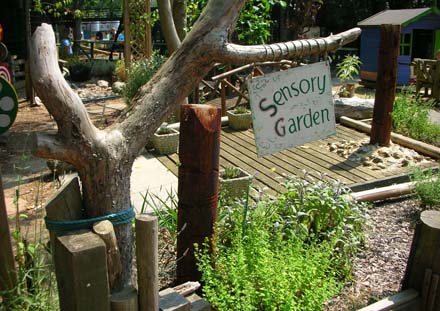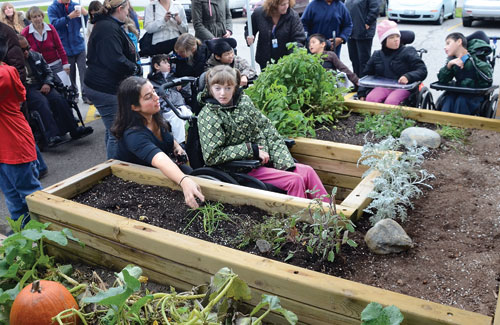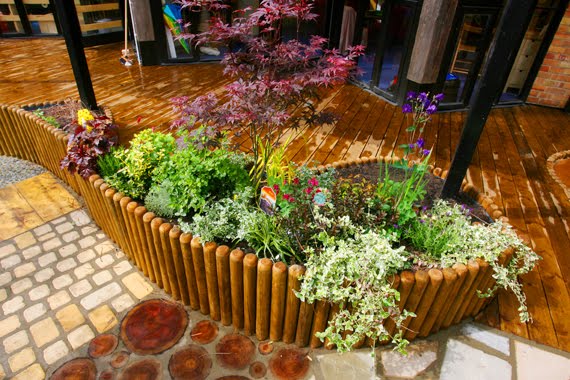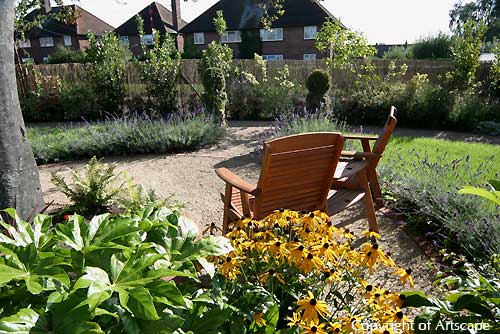Eva C. Worden and Kimberly A. Moore
What is a sensory Garden?
Some gardens stimulate the senses to a greater degree than others. In sensory gardens, plants and other design elements are selected with intention to provide experiences for seeing, smelling, hearing, touching, and tasting.
Well-designed sensory gardens can be simultaneously stimulating and relaxing. They can be created in spaces that are small or large, private or public.
Sensory gardens can be
- Devoted specifically to one sense, such as a fragrance garden.
- Focused on several senses, with separate sections devoted to each sense.
- A blend that enlivens all of the senses throughout the garden.
Home Gardening Australia gives you the information and tips to help you learn more about sensory gardens and transform your own home garden to a sensory delight.
Designing a Sensory Garden
The Function of a Sensory Garden
Sensory gardens can serve many purposes and should be designed with their specific function in mind. Such functions include
- Enlivening and renewing the ill or weakened physically, mentally, or spiritually.
- A venue for teaching, socializing, healing and horticultural therapy.
- A resource for health care facilities such as nursing homes and hospitals, schools, parks, botanic gardens, and other institutions.
The audiences and objectives for every sensory garden may vary; however, a number of design considerations are common to all.
The Hardscape Elements
Hardscape elements are the components of the landscape not composed of living plants–paths, benches, arbors, walls, etc. Here are some points to consider:
Paths
- Paving materials for garden paths can vary throughout the garden, to provide desirable challenges for wheelchair users.
- Block paving, timber decking, mulch, and stone are some options, but may become slippery when wet.
- Pathway width should be a minimum of 48 inches, with an ideal of 60 inches for wheelchair access.
Beds
- Raised planting beds can provide easy access to plants for all garden users.
- Beds are especially helpful to the vision impaired and wheelchair users.
- Beds placed at lower heights comfortable for children will encourage them to explore the plantings.
Seating
- Seating in the sensory garden should be placed strategically for functionality and to maximize enjoyment of the space.
- Seating can be an opportunity for sensory experience.
- Large, rough-textured tree stumps can be grouped together.
- Smooth metal benches can becomes warm or cool depending on the position of the sun.
- Seating with pergolas and gazebos can incorporate fragrant plants.
Signage
- Visitors will be more inclined to interact with plants if they are prompted by clear labeling.
- Use color coded signage that highlights the different senses associated with each plant.
- Braille plant labels placed at accessible locations, such as the backface of a handrail, can be used for the visually-impaired.
- A recorded audio system can provide information to the visually-impaired who do not read Braille.
- A brochure with photographs and a plant list can serve as a guide during the garden visit, and as a take-home educational piece.
The Plant Selection
As in designing any garden, plants should be selected that will thrive in the environment particular to each garden. Consider:
- Encouraging users to interact with the plants, often directly, for instance by breaking off leaves to smell or taste.
- Avoiding plants that would require pesticide applications .
- Avoiding poisonous or allergenic plants.
- Using plants which serve multiple roles, for example, mints provide both scent and taste opportunities.
- Using a themed design, such as plants from different regions of the world or cultures, moonlight gardens, and medicinal plants.
The Senses
Sight
Colour, visual texture, form, movement, light and shadow stimulate the sense of sight. Contrasts of these elements add to the sensory experience. Consider:
- Creating unity, rhythm, focal points, accents, and definition with colour.
- Using warm colors such as red, orange, and yellow, to eliven the emotions and promote activity.
- Using cool colors, such as blue, purple, and white, which tend to be soothing, to promote tranquility.
- Using large blocks of riotous colour to help partially sighted persons perceive them.
- Using flowers, colourful fruits, foliage, and bark.
- Incorporating plants with an interesting visual texture, such as smooth, rough, ruffled, fuzzy, or lacey.
- Incorporating different forms of plants, including upright, open, weeping, cascading, or columnar.
- Incorporating plants with round, toothed, and spherical leaves and fruit.
- Adding movement with plants that sway in the wind, moving water features, pools with floating leaves or flowers, fish in ponds, butterflies and birds.
- Planting beds that draw the eye through a sequence of focal points and vistas.
- Using contrast with light and shadow, such as subtle dappled sunlight through a shade tree, or a dramatic dark tunnel of willow or vines that leads to an area of full sun.
- Using accessories like color flood lights, torches, mirrors, and gazing globes, mobiles and sculpture.
Sound
Opening the ears in a garden expands the senses and broadens the garden encounter. Consider the sound of:
- Wind rushing through the leaves.
- Jostling elements, such as bamboo stems knock together, grasses rustle, palm fronds sway.
- Seed pods, which make natural maracas, or sound shakers.
- Leaves on the ground, that crunch underfoot.
- Animal noises.
- Squirrels that chatter and scramble.
- Birdsongs, with birds baths, bird-attracting plants, bird feeders and bird houses.
- Accessories such as waterfalls, fountains, water harps, windchimes and music piped in through outdoor speakers.
Smell
The sense of smell is deeply emotional and associative. This can be especially meaningful for the visually impaired. Crushing and smelling a plant part is a classic method of plant recognition and identification.
With thoughtful planning and design, you can incorporate fragrances into a garden. Consider:
- Including delicate nasturtium blossoms.
- Including the heady perfume of gardenia
- Including the resinous scent of pine needles.
- Including edible species, such as tomatoes, citrus, and of course, herbs and spices.
- The time of day visitors will use your garden, as some plants release their fragrance into the air with the heat of the sun, while others release their scent only when crushed.
- Including confederate jasmine in a nighttime garden.
- Placing fragrant plants alongside garden seating.
- Planting in large pots placed along the garden paths, which can be brushed and touched without stooping.
- Planting fragrant creeping herbs, such as thyme, among pathways, which will release their aroma when walked or wheeled over.
- The timing of your garden maintenance activities, for example, the smell of lawn mower exhaust is unappealing, but the fragrance of freshly cut grass can be delightful.
- Mowing turf areas shortly before garden users arrive to optimise smell.
- Including accessories such as incense and scented oils in garden torches.
Touch
In a sensory garden, people should be encouraged to touch plants. Plants should be chosen that are durable enough to withstand frequent brushing or handling. Consider:
- Incorporating soft flowers, fuzzy leaves, springy moss, rough bark, succulent leaves, prickly seed pods, sticky fruit and gooey plant saps.
- Using species that offer a variety of textures within a single plant, for example, the rose has delicate petals and thorny stems, or the silver buttonwood, which has rough bark and soft grey leaves, or the southern magnolia, with its leaves slick, shiny, and dark green above, and soft, felted brown beneath.
- Placing plants that may be dangerous to the visually impaired, such as spiny agaves or roses, out of accidental reach or toward the back of planting beds.
- Including a lawn where people can lie down.
- Incorporating water features within reach, with water lilies and other aquatic plants.
- Including outdoor misting machines and sculpture.
Taste
In a sensory garden, the tastebuds can tingle from edible fruits, vegetables, herbs, and spices. Consider:
- Including plants that can produce a large number of edible parts over time, such as mint leaves, strawberries, or edible flowers, rather than species with more limited production, such as cantaloupe.
- Providing teaching opportunities around edible landscaping, agriculture, nutrition and cultural exchange over food plants.
- Providing space for food preparation, cooking, and eating brings taste directly to the garden, such as an outdoor barbeque grill or picnic table in the shade.
- Including a small pavillion for preparing herbal tea from the garden will add an Eastern cultural element.
Additional Reading
- Color By Design. Pope, Nori, et al. 1998. SOMA Books.
- The Complete Book of Edible Landscaping: Home Landscaping with Food-Bearing Plants and Resource-Saving Techniques. Rosalind Creasy. 1982. Sierra Club Books.
- Continuous Color. Pam Duthie. 2004 Ball Publishing
- Edible Garden. Editors of Sunset Books. 2004. Oxmoor House
- Fragrant Designs. Beth Hanson (editor). 2009. Brooklyn Botanic Garden.
- Fragrant Gardening. Bradley, Steve, et al. 2003. Laurel Glen.
- Healing Garden: A Natural Haven for Body, Senses, and Spirit. Minter, Sue. 1996. Charles E. Tuttle Co., Inc.
- Healing Gardens. Rawlings, Romy. 1999. Willow Creek Press.
- The Herb Bible: a complete guide to growing and using herbs. Jennie Harding. 2005. Parragon
- Landscaping with Herbs. James Adams. 1987. Timber Press.
- Malcolm Hillier’s Color Gardening. Hillier, Malcolm, et al. 1999. DK Publishing.
- Water Features for Small Gardens: From Concept to Construction. Keith Davitt. 2003. Timber Press.
This document has been adapted from a series of the Environmental Horticulture Department, Florida Cooperative Extension Service, Institute of Food and Agricultural Sciences, University of Florida. Original publication date March 2003. Reviewed June 2004 and March 2010. Visit the EDIS web site at http://edis.ifas.ufl.edu.




